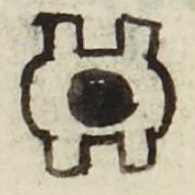Olin (MH634v)
This black-line drawing of the compound glyph for the personal name Olin ("Movement" or "Earthquake," attested here as a man's name) shows a quincunx shape with a round black center, probably a rubber (olli) ball, and four prongs, two at the top and two at the bottom. The quincunx suggests movement (olin).
Stephanie Wood
As is often the case with these compounds, between dropped and intrusive "n's" and the use of "ll" when "l" is all that is needed, it can be a challenge to see whether the intention is olli or olin. But, here, the framework around the ball would not be necessary if just olli was the intention. So, the name Olin is preferred in this case.
Olin was a day name in the 260-day divinatory calendar called the tonalpohualli in Nahuatl. This calendar had a role in various Mesoamerican religions, including the Mixtec.
Stephanie Wood
ollin
Olin
Stephanie Wood
1560
Jeff Haskett-Wood
movement, movimiento, hule, pelotas, balls, rubber, nombres de hombres
This detail of an olin glyph comes from a work of art by Mariana Castillo Deball, “Cocodrilo piel de los días” (2021), serving as yet another example of how interest in ancestral writing lives on in modern times. Museo de Arte de Zapopan. Photo by S. Wood, 17 April 2025.

ol(in), movement, earthquake, https://nahuatl.wired-humanities.org/content/olin
ol(li), rubber, ball, https://nahuatl.wired-humanities.org/content/olli
Movimiento, o Temblor
Stephanie Wood
Matrícula de Huexotzinco, folio 634v, World Digital Library, https://www.loc.gov/resource/gdcwdl.wdl_15282/?sp=351.
This manuscript is hosted by the Library of Congress and the World Digital Library; used here with the Creative Commons, “Attribution-NonCommercial-ShareAlike 3.0 License” (CC-BY-NC-SAq 3.0).







